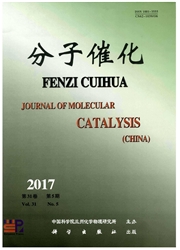

 中文摘要:
中文摘要:
以光催化还原水制氢为指标反应系统地考察了若干种染料对TiO2的共敏化作用,研究表明曙红Y(EosinY,EY)和玫瑰红(Rose Bengal,RB)对TiO2的共敏化效果最为显著,而钌染料(Ru(bipy)3Cl2,Ru)分别与EY和RB的共敏化效果则不显著或没有共敏化效应.UV-Vis吸收光谱和荧光光谱技术对染料共敏化体系的表征结果表明,在EY/RB体系中显著的共敏化效应不仅与染料对可见光的吸收增加有关,而且还与染料分子之间的荧光共振能量转移(FRET)有关,这种荧光共振能量转移可有效降低染料激发态由于荧光猝灭导致的能量损失,提高光催化产氢效率.瞬态光电流实验和单色光产氢实验结果也进一步确证了这种作用.我们的研究结果还表明,在Ru/EY和Ru/RB体系中,必须加入甲基紫精作为电子中继试剂才能使催化剂具有光催化活性.在优化的反应条件下(λ≥420 nm),EY/RB共敏化体系的产氢量子效率分别比EY和RB单一染料敏化体系提高了36.3%和215.4%.
 英文摘要:
英文摘要:
The cosensitized effects of TiO2 by various dyes were investigated using photocatalytic water reduction for hydrogen production as a model reaction. The results showed that there was a profound cosensitization effect when Eosin Y (EY) and Rose Bengal (RB) were used as cosensitizer, while the combination of Ru(bipy)3Cl2 either with EY or RB did not show any cosensitization effects for hydrogen production. For EY/RB cosensitized systems, the UV-vis absorption spectra and fluorescence spectrum revealed that the remarkable cosensitization effect in EY/ RB systems originated from not only the enhanced light absorption efficiency, but also the effective F~rster resonant energy transfer (FRET) between two dyes, which could effectively reduce the energy loss due to the fluorescence quenching of excited state dyes, and enhance the photocatalytic efficiency of hydrogen production. This conclusion was confirmed by the transient photocurrent and monochromic light experiments. Our results also showed that the Ru/EY and Ru/RB cosensitized systems only exhibited photoreactivity for hydrogen production in the presence of methyl viologen ( MV2+ ) as electron transfer relay. Under optimal conditions ( A 〉1420 nm) , the apparent quantum yield (AQY) of hydrogen production for EY/RB cosensitized systems was 36.3% and 215.4% higher than that of single EY and RB sensitized systems, respectively.
 同期刊论文项目
同期刊论文项目
 同项目期刊论文
同项目期刊论文
 Enhanced Electron Transfer from the Excited Eosin Y to mpg?C3N4 for Highly Efficient Hydrogen Evolut
Enhanced Electron Transfer from the Excited Eosin Y to mpg?C3N4 for Highly Efficient Hydrogen Evolut Sites for High Efficient Photocatalytic Hydrogen Evolution on a Limited-Layered MoS2 Cocatalyst Conf
Sites for High Efficient Photocatalytic Hydrogen Evolution on a Limited-Layered MoS2 Cocatalyst Conf Selective growth of Ag3PO4 submicro-cubes on Ag nanowires to fabricate necklace-like heterostructure
Selective growth of Ag3PO4 submicro-cubes on Ag nanowires to fabricate necklace-like heterostructure Visible light induced CO2 reduction and Rh B decolorization over electrostatic-assembled AgBr/palygo
Visible light induced CO2 reduction and Rh B decolorization over electrostatic-assembled AgBr/palygo Selective Growth of Metallic Ag Nanocrystals on Ag3PO4 Submicro-Cubes for Photocatalytic Application
Selective Growth of Metallic Ag Nanocrystals on Ag3PO4 Submicro-Cubes for Photocatalytic Application Noble-metal-free NiSnxOy decorated graphene cocatalyst for highly efficient reduction of water to hy
Noble-metal-free NiSnxOy decorated graphene cocatalyst for highly efficient reduction of water to hy Enhancing catalytic activity and stability for CO2 methanation on Ni-Ru/gamma-Al2O3 via modulating i
Enhancing catalytic activity and stability for CO2 methanation on Ni-Ru/gamma-Al2O3 via modulating i Modulating Photogenerated Electron Transfer and Hydrogen Production Rate by Controlling Surface Pote
Modulating Photogenerated Electron Transfer and Hydrogen Production Rate by Controlling Surface Pote New evidence for the regulation of photogenerated electron transfer on surface potential energy cont
New evidence for the regulation of photogenerated electron transfer on surface potential energy cont The roles of density-tunable surface oxygen vacancy over bouquet-like Bi2O3 in enhancing photocataly
The roles of density-tunable surface oxygen vacancy over bouquet-like Bi2O3 in enhancing photocataly The roles of various Ni species over SnO2 in enhancing the photocatalytic properties for hydrogen ge
The roles of various Ni species over SnO2 in enhancing the photocatalytic properties for hydrogen ge Visible Photocatalytic Water Splitting and Photocatalytic Two-Electron Oxygen Formation over Cu- and
Visible Photocatalytic Water Splitting and Photocatalytic Two-Electron Oxygen Formation over Cu- and Dye-Sensitized NiSx Catalyst Decorated on Graphene for Highly Efficient Reduction of Water to Hydrog
Dye-Sensitized NiSx Catalyst Decorated on Graphene for Highly Efficient Reduction of Water to Hydrog Enhanced surface electron transfer by fabricating a core/shell Ni@NiO cluster on TiO2 and its role o
Enhanced surface electron transfer by fabricating a core/shell Ni@NiO cluster on TiO2 and its role o Study of catalytic activity and product selectivity of M/Al2O3-CeO2 (M = Pt-Ru, Ru, and Pt) in catal
Study of catalytic activity and product selectivity of M/Al2O3-CeO2 (M = Pt-Ru, Ru, and Pt) in catal Highly active and stable nano NiO-MgO catalyst encapsulated by silica with a core-shell structure fo
Highly active and stable nano NiO-MgO catalyst encapsulated by silica with a core-shell structure fo A novel amorphous CoSnxOy decorated graphene nanohybrid photocatalyst for highly efficient photocata
A novel amorphous CoSnxOy decorated graphene nanohybrid photocatalyst for highly efficient photocata Enhancement of Pt-Ru catalytic activity for catalytic wet air oxidation of methylamine via tuning th
Enhancement of Pt-Ru catalytic activity for catalytic wet air oxidation of methylamine via tuning th Enhanced Electron Transfer from the Excited Eosin Y to mpg-C3N4 for Highly Efficient Hydrogen Evolut
Enhanced Electron Transfer from the Excited Eosin Y to mpg-C3N4 for Highly Efficient Hydrogen Evolut The dual functional roles of Ru as co-catalyst and stabilizer of dye for photocatalytic hydrogen evo
The dual functional roles of Ru as co-catalyst and stabilizer of dye for photocatalytic hydrogen evo Photocatalytic and photoelectric properties of cubic Ag3PO4 sub-microcrystals with sharp corners and
Photocatalytic and photoelectric properties of cubic Ag3PO4 sub-microcrystals with sharp corners and 期刊信息
期刊信息
